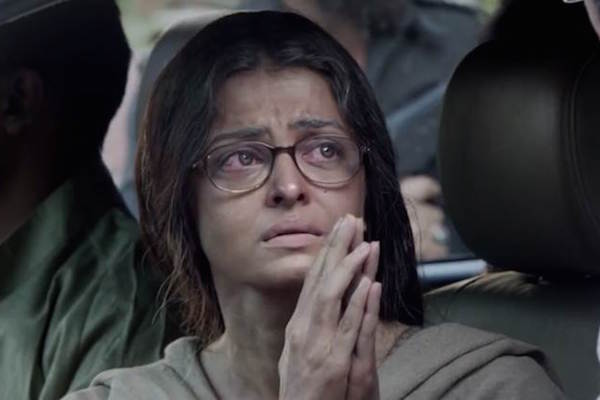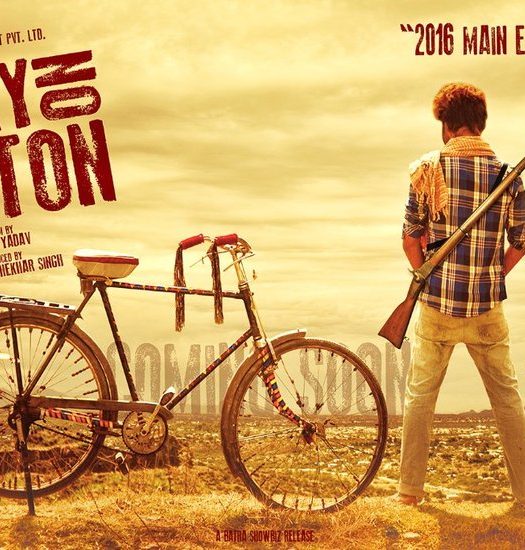It was emotionally gruelling to shoot Sarbjit – Kiran Deohans
Identity crisis, alleged espionage, terrorism charges, presidential mercy and a death sentence. Sarabjit Singh’s life was anything but normal. The pathos of his family and his sister’s war against a state, which was hell bent on prosecuting him is what Omung Kumar’s latest biopic, Sarbjit, is all about. We spoke with cinematographer Kiran Deohans who feels that this film will create curiosity in the audience to read more about the inmate’s life and struggle.
Deohans talks about the film, its form and the choices behind.

Kiran Deohans with Omung Kumar
Your last three projects were Ramaiya Vastavaiya, Agneepath and Celluloid Man. Three projects that are extremely different from each other in terms of their narrative. How do you choose your projects? What excited you about Sarbjit?
To begin with, I don’t do many films. In the last 30 years of my career I have done a maximum of five to six films. That itself says that I pick and choose. It is this choice because of which people come up to me with a decent script only. Then it’s up to me to decide whether I should do the offered film or not. At the same time lots of other offers keep pouring in. I keep myself busy with TVCs and promotional ads. That not only keeps me busy but also gives me the freedom to choose my film projects wisely.
For me, it has nothing to do with mainstream cinema or parallel cinema. What matters is whether there is scope for me to do something different. Whether I can be part of the storytelling process or not. Rather than working in the stereotype of good cinematography that consists of silhouettes and exotic foreign locations, I look for films where I believe that I could add something, which is beyond what’s given in the script.
I like to hear narrations from the director. This gives me the clarity about his vision. After the narration I make my visual pitch to him. Nine out of ten times we are on the same page. Sarbjit fell in that space hence I chose to work on it.
READ: SARABJIT’S STORY IS NOTHING LESS THAT A FILM’S SCRIPT – OMUNG KUMAR
In the film the story travel through a time span of 20 years. How have you used the camera to show the difference in the time periods?
There are a lot of other crutches that we took support of, such as production design, makeup, hair and the actors themselves, by ageing them. Randeep (Hooda) has very successfully done that. For example, we used three different types of dentures for him. It is because when you are imprisoned for 10-12 years and are are deprived of proper dental care, your teeth start to decay. And when those dentures come, your speech pattern changes. So all of that came from the actor’s end.
Light and compositions become very important when you talk about transitions. So, I take a call on things like playing with the light, time of the year and season. I mood-light according to the scene. For instance, there was a news of him in the media and his kin pays him a visit in the cell. Even though there is only a single small window in that eight by four cell, I did not make it gloomy. I took the liberty to make it bright and sunny, so that it reflects the mood of the scene. I’ve taken the help of color palettes; it psychologically keeps suggesting the changes.
Light and compositions become very important when you talk about transitions
From the trailer, the shots of Randeep in the prison cell look claustrophobic. How did you frame the torture sequences? What was the approach for the rest of the scenes?
If you are staying in a prison cell that is so small, then there is a sense of being trapped in a box. As time progresses and the sentence nears, that suffocation too builds out of proportion. It is all conveyed through the lensing and the camera movements. Most of the time in the prison cell sequences I have chosen not to move my camera and have shot on a tripod. If I had moved the camera then a lot of unrequired kinetic energy would’ve been there in the frame, while the requirement was a stagnant visual. Slowly, as Sarbjit’s hopes of getting released start to decay, it is like the walls around him start coming closer and closer and further tighten the space. That was achieved through lighting, composition and lensing.

Randeep Hooda in a still from Sarbjit
Which camera did you shoot the film on? Also, what were the lenses, filters and rigs used and how did you go about making your choice?
I have shot the film on ARRI ALEXA XT and have used Master Prime lenses. There were always two cameras rolling with the same setup of ARRI XT with Master Prime lens. I used Optimo zoom lens (24-290) and I did not do too much of filtering on this. Except for Neutral Density (ND) or sometimes in the exterior, to drop the sky a little bit, I used some graduated filters.
The major camera movements are only when there are exterior shots. There is a little happiness, excitement and a change of mood happening there. So, for all those I used Panther and Jimmy. In a couple of travel shots I have rigged the camera on a vehicle. There are shots where energy was required so for those shots rather than using a handheld I have used a steadicam. So that even if there is a movement it is seen in a gliding manner. In the film there is only one instance where I have used handheld, that’s where Randeep is attacked by the inmates.
READ: AN ACTOR’S FACE IS A CANVAS FOR THE MAKEUP ARTIST – SUBHASH SHINDE
What was the overall color palette you chose for the film? Does it change as the period progresses in the film?
The color palette was actually a combination of the costumes, the way the makeup changes and the lighting supporting all of that. So we chose very muted colors like dull brown. There is no shocking vivid color in Aishwarya (Rai Bachchan)’s costumes. Randeep is wearing monochromatic Chai-Paani kind of shirts all the time. Other palettes of yellows and blues have been used for happy sequences. There are some casual moments in the film where there were less muted colors.
I avoided fluorescent red, green, orange and blue. Blue was strictly avoided in the costume. It is only in the Pakistan sequences that we see it. Blue as a primary color wasn’t used in any property or costume.
We were clear that we did not want a large cell to make it more practical to shoot
How have you used the lighting to add to the narrative? Tell us about the types of lights used for indoor sequences. And your approach to lighting outdoor sequences.
Firstly, I requested my director Omung Kumar to take into account that the size of the set should not be larger than the size of an actual cell. Since it was a set, depending on the shot, I could remove a wall here and there for accommodating my lights and camera. But we were clear that we did not want a large cell to make it more practical to shoot. That was a very important decision that we took.
Secondly, I used a package which had mostly cool lights like HMI. Even if we used a Kino or some other light with a higher color temperature, we would balance it. Most of the times the color temperature was neither 5600 Kelvin nor 4500 Kelvin. It wasn’t very cool and wasn’t very warm either. It’s not normal. We created a feeling of something being abnormal about the color temperature of the light.
For outdoors I shot with the right kind of filtering. While shooting outside, I would normally put my camera on to daylight and try to bring it on to tungsten, so that I get a little blue cast and a little cooler feel. I manipulated a lot with the camera. With ARRI you can play a lot with the color temperature. In today’s time you can play even further in D.I. It really helped me in the outdoor as well as indoors sequences.
As far as the package of lights go, we used Big HMI’s 6K, Helium moon (For the night shots), Kinos, slab lights and skylight.

Aishwarya Rai Bachchan’s look in Sarbjit
What was the biggest set piece in the film? How did you light it up?
This film does not have big sets as it wasn’t required. Most of the setups are simple. The image size is mid close ups or maximum full figure shots. We were shooting in magic hour most of the times so we were running short of time. I was always trying to avoid lighting up, so that I get that nice quality of light that we get after six o’ clock. So, that was a big challenge. Lighting huge sets wasn’t a concern in this project.
Does the film have lip-sync songs. If yes, what was the visual treatment like?
The film has only one song in it. That was luckily a very happy song, a godh-bharai (Baby Shower) sequence, so I had the chance of moving the camera. The movements were choreographed and are in the form of Giddha (Dance form in Punjab). So, it was a right mix of movement and color combinations. It was very bright and sunny and happy. This is also because we were cutting the song with the monochromatic visuals of the inmate in jail. So the whole contrast of the outside world with its freedom and prison cell has come out beautifully. The metaphor works well.
READ: AS DESIGNERS A BIOPIC IS ALWAYS A CHALLENGE – SHAAHID & NEETU
How would you describe the entire experience of shooting this emotional story?
It was very emotionally draining. I am a very emotional person and I cry in emotional scenes in the film. Randeep, Richa (Chadha) and Aishwarya (Rai Bachchan) have done a fantastic job. They will make you cry in many scenes. The film is very powerful in that sense.
Were there any major obstacles you faced during the shoot of the film?
The only obstacle that I faced was time limit. Nothing else!
A lot of us have heard about Sarbjit quite recently but nobody actually knows what happened
What according to you sets Sarbjit apart from the other biopics in terms of the treatment?
A lot of us have heard about Sarbjit quite recently. Nobody actually knows what happened. Was he a detective or was he a normal citizen who walked into the Pakistan border in an intoxicated state. There is a lot of ambiguity on this subject. I read a lot about him during the research of the film. I did not know a lot of facts about him, which I am sure would be very interesting for the audiences too. There is a certain mystery about him. It’s not like a Gandhi or a Lincoln about whom the facts are in black and white. It’s a different kind of a biopic.
Please talk about your camera team. Was it a new team or an old association?
My chief assistant is Pramod Gaekwad. He was with me on Jodha Akbar, Ramaiya Vastavaiya and Agneepath. Another assistant is Suneet Vats. My gaffers are Abdul and Dinesh. These are my fixed people. I believe that focus pulling is one of the most underrated jobs but is one of the most important jobs. My focus puller is Sunny who knows his stuff really well. My shots never go out of focus. Thanks to these guys without whose support things would’ve been difficult.


